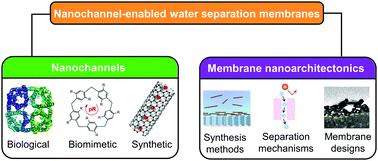当前位置:
X-MOL 学术
›
Chem. Soc. Rev.
›
论文详情
Our official English website, www.x-mol.net, welcomes your
feedback! (Note: you will need to create a separate account there.)
The coming of age of water channels for separation membranes: from biological to biomimetic to synthetic
Chemical Society Reviews ( IF 40.4 ) Pub Date : 2022-05-16 , DOI: 10.1039/d1cs01061a Yu Jie Lim 1, 2, 3 , Kunli Goh 1 , Rong Wang 1, 2
Chemical Society Reviews ( IF 40.4 ) Pub Date : 2022-05-16 , DOI: 10.1039/d1cs01061a Yu Jie Lim 1, 2, 3 , Kunli Goh 1 , Rong Wang 1, 2
Affiliation

|
Water channels are one of the key pillars driving the development of next-generation desalination and water treatment membranes. Over the past two decades, the rise of nanotechnology has brought together an abundance of multifunctional nanochannels that are poised to reinvent separation membranes with performances exceeding those of state-of-the-art polymeric membranes within the water–energy nexus. Today, these water nanochannels can be broadly categorized into biological, biomimetic and synthetic, owing to their different natures, physicochemical properties and methods for membrane nanoarchitectonics. Furthermore, against the backdrop of different separation mechanisms, different types of nanochannel exhibit unique merits and limitations, which determine their usability and suitability for different membrane designs. Herein, this review outlines the progress of a comprehensive amount of nanochannels, which include aquaporins, pillar[5]arenes, I-quartets, different types of nanotubes and their porins, graphene-based materials, metal– and covalent–organic frameworks, porous organic cages, MoS2, and MXenes, offering a comparative glimpse into where their potential lies. First, we map out the background by looking into the evolution of nanochannels over the years, before discussing their latest developments by focusing on the key physicochemical and intrinsic transport properties of these channels from the chemistry standpoint. Next, we put into perspective the fabrication methods that can nanoarchitecture water channels into high-performance nanochannel-enabled membranes, focusing especially on the distinct differences of each type of nanochannel and how they can be leveraged to unlock the as-promised high water transport potential in current mainstream membrane designs. Lastly, we critically evaluate recent findings to provide a holistic qualitative assessment of the nanochannels with respect to the attributes that are most strongly valued in membrane engineering, before discussing upcoming challenges to share our perspectives with researchers for pathing future directions in this coming of age of water channels.
中文翻译:

分离膜水道时代的到来:从生物到仿生到合成
水道是推动下一代海水淡化和水处理膜发展的关键支柱之一。在过去的二十年中,纳米技术的兴起汇集了大量多功能纳米通道,这些纳米通道有望重新发明分离膜,其性能超过水-能源关系中最先进的聚合物膜。如今,这些水纳米通道可以大致分为生物、仿生和合成,因为它们具有不同的性质、物理化学性质和膜纳米结构的方法。此外,在不同分离机制的背景下,不同类型的纳米通道表现出独特的优点和局限性,这决定了它们对不同膜设计的可用性和适用性。在此处,2, 和 MXenes,让他们比较了解它们的潜力所在。首先,我们通过研究纳米通道多年来的演变来绘制背景,然后从化学的角度关注这些通道的关键物理化学和内在传输特性来讨论它们的最新发展。接下来,我们展望了可以将纳米结构水通道变成高性能纳米通道膜的制造方法,特别关注每种纳米通道的明显差异以及如何利用它们来释放所承诺的高水传输潜力在当前主流的膜设计中。最后,
更新日期:2022-05-16
中文翻译:

分离膜水道时代的到来:从生物到仿生到合成
水道是推动下一代海水淡化和水处理膜发展的关键支柱之一。在过去的二十年中,纳米技术的兴起汇集了大量多功能纳米通道,这些纳米通道有望重新发明分离膜,其性能超过水-能源关系中最先进的聚合物膜。如今,这些水纳米通道可以大致分为生物、仿生和合成,因为它们具有不同的性质、物理化学性质和膜纳米结构的方法。此外,在不同分离机制的背景下,不同类型的纳米通道表现出独特的优点和局限性,这决定了它们对不同膜设计的可用性和适用性。在此处,2, 和 MXenes,让他们比较了解它们的潜力所在。首先,我们通过研究纳米通道多年来的演变来绘制背景,然后从化学的角度关注这些通道的关键物理化学和内在传输特性来讨论它们的最新发展。接下来,我们展望了可以将纳米结构水通道变成高性能纳米通道膜的制造方法,特别关注每种纳米通道的明显差异以及如何利用它们来释放所承诺的高水传输潜力在当前主流的膜设计中。最后,











































 京公网安备 11010802027423号
京公网安备 11010802027423号